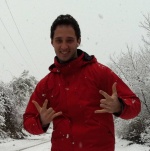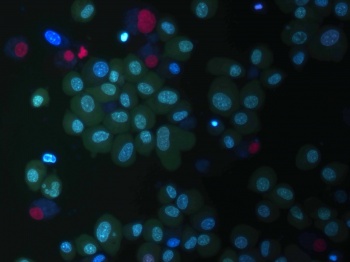Alexandre Teixeira Vessoni
From DNA Repair Lab
(Difference between revisions)
| Revision as of 20:18, 10 November 2011 Root (Talk | contribs) ← Previous diff |
Revision as of 20:25, 10 November 2011 Root (Talk | contribs) Next diff → |
||
| Line 1: | Line 1: | ||
| {| | {| | ||
| |- | |- | ||
| - | |[[Image:Alexandre.JPG|150px]] | + | |http://www.icb.usp.br/~mutagene/images/thumb/4/44/Alexandre.JPG/150px-Alexandre.JPG |
| - | |Formado em Ciências Biológicas pela Universidade de São Paulo, desenvolve projeto de doutorado direto intitulado "Análise da Autofagia em resposta à danos ao DNA" no Departamento de Microbiologia do Instituto de Ciências Biomédicas da USP.<br> | + | |Graduate in Biological Sciences (University of São Paulo), develops a PhD project entitled "Autophagy Analysis in response to DNA damage" in the Department of Microbiology, Institute of Biomedical Sciences, University of São Paulo, São Paulo, SP, Brazil. |
| + | <br> | ||
| |- | |- | ||
| Line 9: | Line 10: | ||
| == Resumo do Projeto == | == Resumo do Projeto == | ||
| - | Autofagia é um processo dependente de lisossomos que promove a reciclagem de componentes citoplasmáticos, como organelas e proteínas, visando a manutenção da homeostase celular. | + | Autophagy is a lysosomal-dependent degradative pathway that promotes recycling of cytoplasmic components, such as organelles and proteins, aiming at maintaining cellular homeostasis. |
| <br> | <br> | ||
| - | Este processo é ativado em resposta a diferentes estímulos, como falta de nutrientes, estresse oxidativo e lesões ao DNA. Deficiências nesta via estão intimamente relacionadas a diversas condições patológicas, como problemas cardíacos, câncer, neurodegeneração e envelhecimento. | + | This process can be activated under different stressful situations, such as starvation, oxidative stress and DNA damage. Deficiencies in this pathway were associated to cardiopathies, cancer, neurodegeneration and aging. |
| - | <br> | + | In this lab, we develop a project that aims at investigating autophagy in response to UV-induced lesions on the DNA in skin human fibroblasts, as well as the importance of this degradative pathway in glioma cells exposed to different chemotherapeutic agents. |
| - | Desenvolvo um projeto que visa investigar a resposta autofágica frente a danos ao DNA induzidos por luz UV em fibroblastos humanos de pele, bem como a importância da autofagia em células de glioma tratada com diferentes quimioterápicos. | + | <br><br> |
| - | + | ||
| <center> | <center> | ||
| - | [[Image:Foto1Alexandre.jpg|350px]] | + | http://www.icb.usp.br/~mutagene/images/thumb/a/ab/Foto1Alexandre.jpg/350px-Foto1Alexandre.jpg |
| <br> | <br> | ||
| - | Análise por microscopia de fluorescência de vacúolos autofágicos em células de glioma (U87MG) transduzidas com LC3-GFP (lentivírus) | + | Autophagosomes in glioma cells (U87MG) stably expressing LC3-GFP (lentiviral transduction) can be analyzed under a fluorescence microscope. |
| <br><br> | <br><br> | ||
| - | [[Image:Foto2Alexandre.jpg|350px]] | + | http://www.icb.usp.br/~mutagene/images/thumb/5/51/Foto2Alexandre.jpg/350px-Foto2Alexandre.jpg |
| + | |||
| <br> | <br> | ||
| - | Análise de células viáveis (citoplasma verde, núcleo azul e íntegro), necróticas (células vermelhas) e células em apoptose inicial (citoplasma verde e núcleo azul compactado) por microscopia de fluorescência após marcação com os corantes Hoechst, Iodeto de Propídio e Diacetato de Fluoresceína. | + | Viable (green cytoplasm; blue and integrate nucleus), necrotic (red nucleus) and early apoptotic cells (green cytoplasm; blue and condensed nucleus) can be analyzed under a fluorescence microscope after stainning with Propidium Iodide, Hoechst and Fluorescein Diacetate. |
| </center> | </center> | ||


